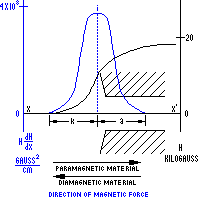|
Separation
in the Barrier Field
The
stream of particles traveling through the field of the Magnetic Barrier
Laboratory separator is split by opposed magnetic and nonmagnetic
forces. Magnetic force transverse to field direction deflects particles
of selected susceptibility from the paths in which gravity urges them.
The process is continuous.
The
paths of all material undergoing separation, including the most strongly
magnetic components, are parallel to the midplane between the opposed
faces of the pole pieces, perpendicular to the flux path. Near the
midplane, where the stream of material undergoes separation, force
attracting particles toward the pole pieces is negligible, no matter
how strongly they are magnetized.
Magnetic
energy gradient (HdH/dx)
in the separating region of the Barrier field has a pattern that may
be likened to a packet of thin sheets, with their surfaces aligned
with the lengthwise axis of the gap between the pole pieces. Along
the length of each sheet magnetic energy gradient transverse to field
direction is constant. Across the width of the separating region magnetic
energy gradient transverse to field direction rises from sheet to
sheet, from low values at the outer fringes of the field to maximum
value at a sheet near the center of the separating region.
Material
is moved by gravity across the field, through the succession of sheets
of ascending
|
magnetic force, toward
the region of maximum transverse force. Particles of like susceptibility
encounter like magnetic force per unit volume.
Particles
having susceptibility such that magnetic force opposing their motion
exceeds gravitational force are deflected in the vicinity of the sheet
of maximum transverse force, while particles having susceptibility
that is weaker or of opposite sign pass through it. A component of
gravity urges both fractions toward a mechanical divider and out of
the field.
Conventional
separators employ magnetic force aligned with field direction to attract
particles toward magnetized collecting surfaces. Magnetic force has
maximum value at such a surface and decreases rapidly with distance
from the surface. The force experienced by any particle in conventional
separators depends on the accident of its position in the field. Particles
passing close to a surface may be captured, while particles passing
farther away may escape.
The
Barrier technology, by providing conditions in which particles of
like susceptibility encounter like magnetic force per unit volume,
has inherent advantages in selectivity and sensitivity for separating
materials according to slight differences in susceptibility.1
|
|

 Figure
2.Superimposed
graphs of magnetic field intensity, H, and magnetic energy gradient,
HdH/dx,
at the midplane x-x’, between the opposed pole faces show the characteristics
of the barrier field and its location near the outer edge of the gap.
The graphs are based on measurements taken at the midplane with maximum
current of about 1.8A supplied to the coils. Figure
2.Superimposed
graphs of magnetic field intensity, H, and magnetic energy gradient,
HdH/dx,
at the midplane x-x’, between the opposed pole faces show the characteristics
of the barrier field and its location near the outer edge of the gap.
The graphs are based on measurements taken at the midplane with maximum
current of about 1.8A supplied to the coils.
In the
katadynamic region, k, energy gradient increases in the direction
in which field intensity increases. At the isodynamic plane, i, it
reaches maximum value. In the anadynamic region, a, energy gradient
declines in the direction in which field intensity increases, reaching
zero value where field intensity is maximum and uniform.
|
| 1.
U.S. Patent No. 4,235,710, issued Nov. 25, 1980 to Jack
J. Sun, assigned to S. G. Frantz Co. Inc., covers means and methods
for separating material at a magnetic barrier; the Company holds similar
patents in countries which constitute its principal markets. |